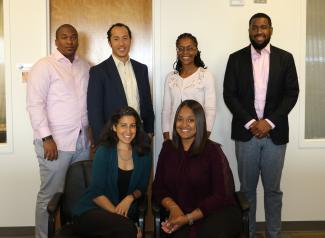Addressing the Root Problems of Crime and Conflict
Last week, the Obama Foundation announced its second-ever class of Fellows, a group of 20 civic innovators from around the world who are working to address society’s most pressing problems. These Fellows work on issues ranging from criminal justice reform and climate justice to leveraging technology for community organizing and helping college graduates build careers. This elite two-year program offers hands-on training, resources, and leadership development to equip Fellows to scale the impact of their work.
Among the select class is Seema Gajwani, OAG’s Special Counsel for Juvenile Justice Reform and chief of OAG’s Restorative Justice and Victim Services Section. In 2016, Seema helped launch OAG’s in-house restorative justice program, a program that addresses the root problems of crime and conflict. The program is one of several evidence-based public safety programs that are alternatives to traditional prosecution and aim to address the root causes of crime and put young people on the right path.
What is restorative justice?
Restorative justice uses mediation to empower victims to express how they were affected by crime and requires offenders to accept responsibility and work to repair the harm they cause. This mediation is an option agreed upon by all parties and the victim can choose to end the mediation at any time.
Restorative Justice has three main steps:
- Actions: The young person who committed the crime describes their actions face-to-face with the victim they harmed. Then the victim describes the actions from their point of view.
- Impact: The victim describes how the crime has negatively impacted their life. Next, others impacted by the crime, including family and friends invited to the mediation, describe how the crime has affected them.
- Repair: All parties agree what actions the offender can take to repair the harm of the crime and they are formalized in a written agreement. OAG restorative justice facilitators monitor compliance with this agreement and, if they are met, the charges are dismissed. If the offender does not comply with the agreement, the case is referred back for traditional prosecution.
How is OAG an innovator in this space?
While other jurisdictions have implemented restorative justice programs, OAG is the first prosecutor’s office to do so in-house. This allows prosecutors to see the benefits of restorative justice first-hand and increasingly offer it as an alternative to victims in eligible cases, which range from theft and property damage to more serious crimes like assault. Gun-related offenses are not eligible for restorative justice.
To date, OAG has completed 95 restorative justice mediations and only five have been referred back to traditional prosecution because of non-compliance with the written agreement.
What is the impact of restorative justice?
Nationwide statistics show restorative justice programs have better success than traditional prosecution at rehabilitating offenders, including lower recidivism and costs and increased victim satisfaction.. Far too often, traditional approaches to prosecution of juveniles and young people simply lead to more contact with the justice system and greater recidivism. Harsh sentences from traditional prosecution don’t make communities safer—and they disproportionately affect the poor and people of color. OAG’s in-house restorative justice program is a data-driven alternative that helps get youth on the right path and enhance public safety.
As chief prosecutor for juvenile offenses in the District of Columbia, AG Racine is working to make the District safer and fairer for all its residents. Learn about more evidence-based criminal justice reforms OAG has implemented in the District.

